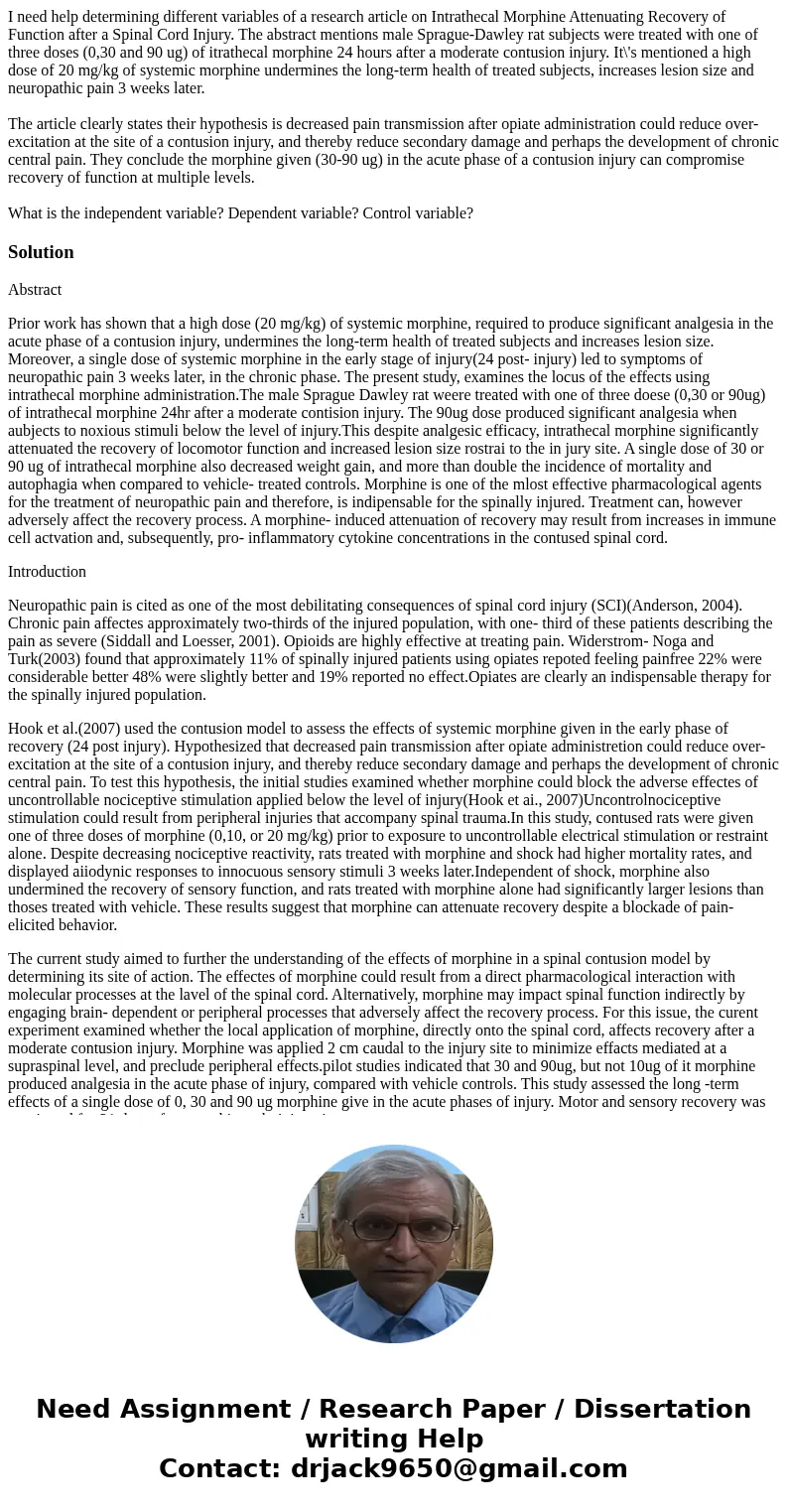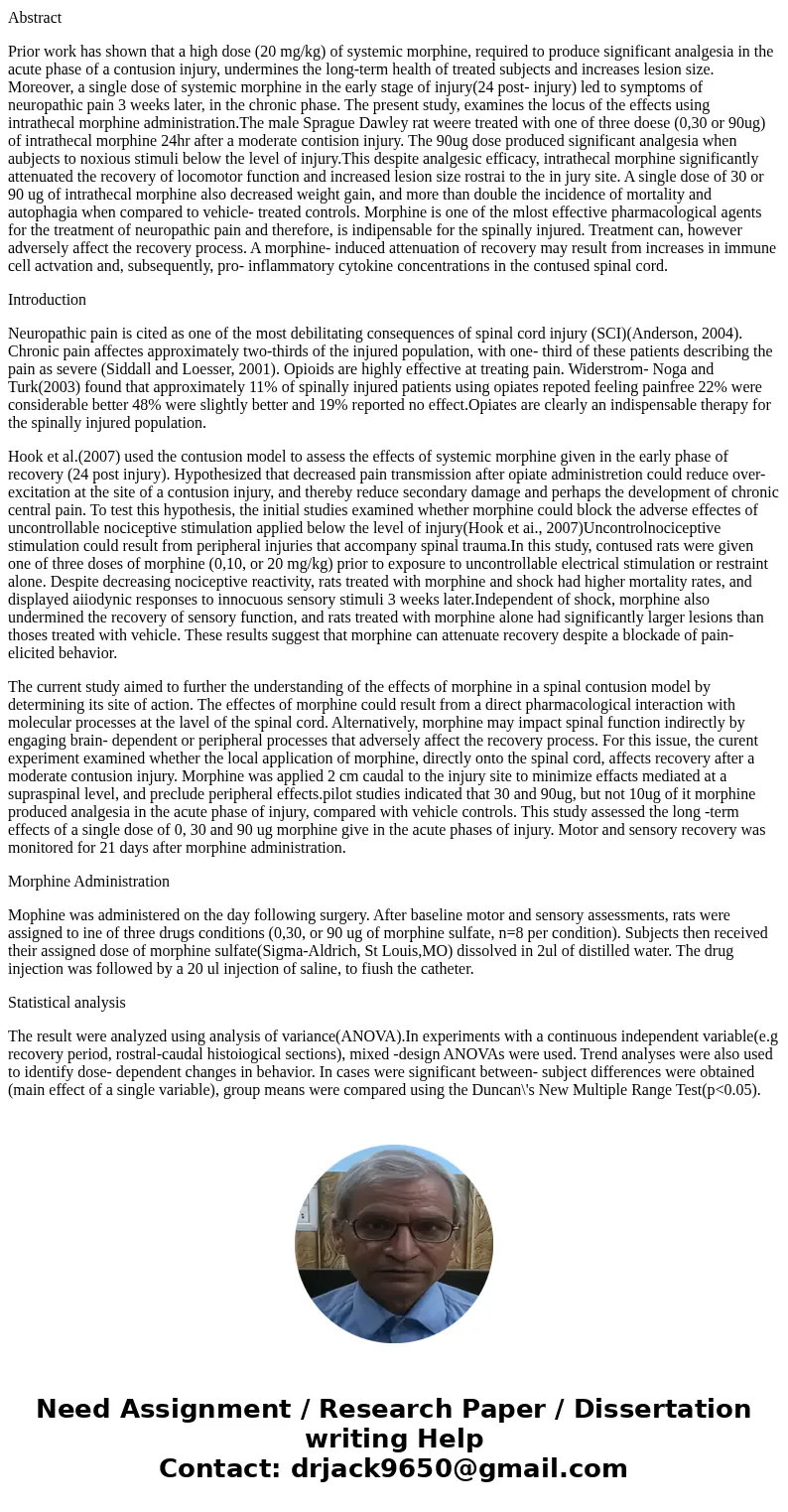I need help determining different variables of a research ar
I need help determining different variables of a research article on Intrathecal Morphine Attenuating Recovery of Function after a Spinal Cord Injury. The abstract mentions male Sprague-Dawley rat subjects were treated with one of three doses (0,30 and 90 ug) of itrathecal morphine 24 hours after a moderate contusion injury. It\'s mentioned a high dose of 20 mg/kg of systemic morphine undermines the long-term health of treated subjects, increases lesion size and neuropathic pain 3 weeks later.
The article clearly states their hypothesis is decreased pain transmission after opiate administration could reduce over-excitation at the site of a contusion injury, and thereby reduce secondary damage and perhaps the development of chronic central pain. They conclude the morphine given (30-90 ug) in the acute phase of a contusion injury can compromise recovery of function at multiple levels.
What is the independent variable? Dependent variable? Control variable?
Solution
Abstract
Prior work has shown that a high dose (20 mg/kg) of systemic morphine, required to produce significant analgesia in the acute phase of a contusion injury, undermines the long-term health of treated subjects and increases lesion size. Moreover, a single dose of systemic morphine in the early stage of injury(24 post- injury) led to symptoms of neuropathic pain 3 weeks later, in the chronic phase. The present study, examines the locus of the effects using intrathecal morphine administration.The male Sprague Dawley rat weere treated with one of three doese (0,30 or 90ug) of intrathecal morphine 24hr after a moderate contision injury. The 90ug dose produced significant analgesia when aubjects to noxious stimuli below the level of injury.This despite analgesic efficacy, intrathecal morphine significantly attenuated the recovery of locomotor function and increased lesion size rostrai to the in jury site. A single dose of 30 or 90 ug of intrathecal morphine also decreased weight gain, and more than double the incidence of mortality and autophagia when compared to vehicle- treated controls. Morphine is one of the mlost effective pharmacological agents for the treatment of neuropathic pain and therefore, is indipensable for the spinally injured. Treatment can, however adversely affect the recovery process. A morphine- induced attenuation of recovery may result from increases in immune cell actvation and, subsequently, pro- inflammatory cytokine concentrations in the contused spinal cord.
Introduction
Neuropathic pain is cited as one of the most debilitating consequences of spinal cord injury (SCI)(Anderson, 2004). Chronic pain affectes approximately two-thirds of the injured population, with one- third of these patients describing the pain as severe (Siddall and Loesser, 2001). Opioids are highly effective at treating pain. Widerstrom- Noga and Turk(2003) found that approximately 11% of spinally injured patients using opiates repoted feeling painfree 22% were considerable better 48% were slightly better and 19% reported no effect.Opiates are clearly an indispensable therapy for the spinally injured population.
Hook et al.(2007) used the contusion model to assess the effects of systemic morphine given in the early phase of recovery (24 post injury). Hypothesized that decreased pain transmission after opiate administretion could reduce over-excitation at the site of a contusion injury, and thereby reduce secondary damage and perhaps the development of chronic central pain. To test this hypothesis, the initial studies examined whether morphine could block the adverse effectes of uncontrollable nociceptive stimulation applied below the level of injury(Hook et ai., 2007)Uncontrolnociceptive stimulation could result from peripheral injuries that accompany spinal trauma.In this study, contused rats were given one of three doses of morphine (0,10, or 20 mg/kg) prior to exposure to uncontrollable electrical stimulation or restraint alone. Despite decreasing nociceptive reactivity, rats treated with morphine and shock had higher mortality rates, and displayed aiiodynic responses to innocuous sensory stimuli 3 weeks later.Independent of shock, morphine also undermined the recovery of sensory function, and rats treated with morphine alone had significantly larger lesions than thoses treated with vehicle. These results suggest that morphine can attenuate recovery despite a blockade of pain-elicited behavior.
The current study aimed to further the understanding of the effects of morphine in a spinal contusion model by determining its site of action. The effectes of morphine could result from a direct pharmacological interaction with molecular processes at the lavel of the spinal cord. Alternatively, morphine may impact spinal function indirectly by engaging brain- dependent or peripheral processes that adversely affect the recovery process. For this issue, the curent experiment examined whether the local application of morphine, directly onto the spinal cord, affects recovery after a moderate contusion injury. Morphine was applied 2 cm caudal to the injury site to minimize effacts mediated at a supraspinal level, and preclude peripheral effects.pilot studies indicated that 30 and 90ug, but not 10ug of it morphine produced analgesia in the acute phase of injury, compared with vehicle controls. This study assessed the long -term effects of a single dose of 0, 30 and 90 ug morphine give in the acute phases of injury. Motor and sensory recovery was monitored for 21 days after morphine administration.
Morphine Administration
Mophine was administered on the day following surgery. After baseline motor and sensory assessments, rats were assigned to ine of three drugs conditions (0,30, or 90 ug of morphine sulfate, n=8 per condition). Subjects then received their assigned dose of morphine sulfate(Sigma-Aldrich, St Louis,MO) dissolved in 2ul of distilled water. The drug injection was followed by a 20 ul injection of saline, to fiush the catheter.
Statistical analysis
The result were analyzed using analysis of variance(ANOVA).In experiments with a continuous independent variable(e.g recovery period, rostral-caudal histoiogical sections), mixed -design ANOVAs were used. Trend analyses were also used to identify dose- dependent changes in behavior. In cases were significant between- subject differences were obtained (main effect of a single variable), group means were compared using the Duncan\'s New Multiple Range Test(p<0.05).


 Homework Sourse
Homework Sourse